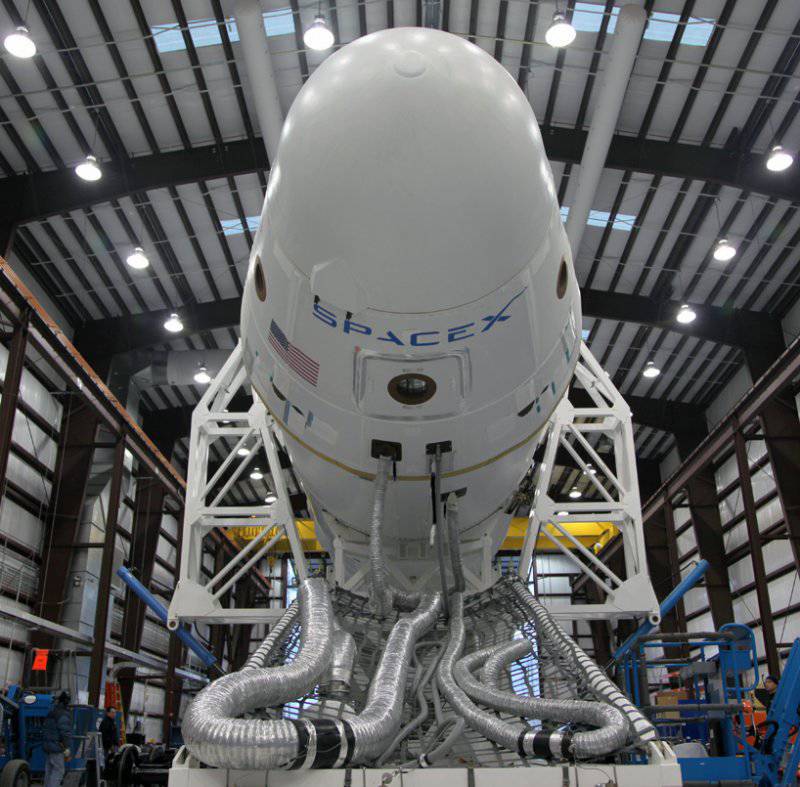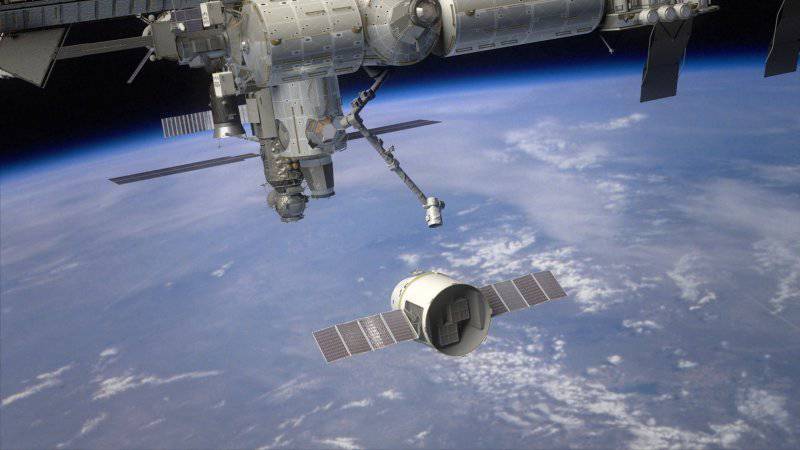SpaceX Dragon, or New Space Competition
Six years spent on the work of the program COST (Commercial Orbital Transportation Service - Commercial Orbital Transport System) finally gave their first results. On May 22, the Falcon-9 launch vehicle with the Dragon spacecraft was launched at the Kennedy Space Center. Three days later, the device approached the International Space Station, was captured by the Canadarm2 manipulator and docked to it. At first glance, the most common event for modern astronautics. However, Dragon is the world's first transport spacecraft, created not by an appropriate state organization, but by a private company. In addition, SpaceX initially adapted its Dragon to commercial use.
Currently, the United States has high hopes for private projects Dragon and Cygnus. The fact is that the closure of the Space Shuttle program turned out to be somewhat unexpected and, by coincidence, NASA did not have one-time spacecraft to deliver cargo and people to orbit. Creating new ones takes time and a considerable amount of money. The resulting "hole" in the space program had to be urgently closed. In 2006, a solution was proposed that was radically new to the world of space exploration. In January of that year, NASA announced the launch of the COST program. The most noticeable moment of this program concerned the involvement of private organizations in the space industry. They were invited to submit their projects to a promising "cargo-passenger" spacecraft. The US space agency has made such a proposal for several reasons. Firstly, NASA has certain difficulties with financing new complex projects, and secondly, the peculiarities of the state structure do not allow it to fully respond to current requirements in a timely manner, which ultimately results in a considerable time. The COST program, in turn, is designed to use the flexibility and other advantages of commercial organizations. At the same time, NASA was able to allocate for the program only one and a half to two costs per ship of the Shuttle-type.
At the end of 2008, the year ended the first stage of the COST program - the consideration of competitive projects. Contracts were concluded with two firms to complete the development and test of two ships. SpaceX and Orbital Sciences were to bring up the Dragon and Cygnus projects, respectively. Work on the "Signus" has not yet come to an end, and the "Dragon" has already made its first flight. It should be noted that the launch of 22 in May was not the first in the “biography” of Dragon. In December, a test flight was made on 2010, during which the prototype of the “Dragon” went into orbit, made a test maneuver and went in for a landing. But at the end of May of this year, Dragon not only demonstrated its capabilities in the flight plan, but also delivered the cargo to the ISS for the first time. Due to the test character of the last launch today, Dragon was carrying loads of non-essential goods - in case of a possible accident. However, the new truck successfully entered orbit and approached the International Station. Thus, the third test launch, which was planned in case of failure in the second flight, is likely to receive new targets.
Before 2016, the XA NUMX cargo flights of the “Dragon” to the ISS will be conducted under the NASA and SpaceX contract. By that time, the development of a manned spacecraft will be completed. Due to its size, the habitable version of the Dragon will be able to deliver a person or an 12 person to orbit, plus two and a half tons of cargo. There are still at least four years left until the piloted version of the Dragon is tested, and SpaceX management is already making plans for it. Thus, the chief designer and concurrently the founding father of Space X, E. Musk, cites very remarkable figures. According to his calculations, delivery to the orbit of one astronaut will cost a little more than 7 million dollars. For comparison, the last space tourist G. Laliberte laid out 4 millions for his journey, and NASA is currently paying about 20-ty for lifting and lowering each astronaut. Obviously, the Dragon project is worth it, if, of course, the promised 35 millions for an astronaut will be true.
Possible great prospects for the "Dragon" are a cause for concern for the employees of Roscosmos. The SpaceX commercial project in the future may become a real competitor for the Russian Soyuz, primarily in economic terms. Meanwhile, the family of Soyuz spacecraft is about to be replenished with another modification, this time the last one. Soyuz TMA-MS is scheduled for commissioning next year. The TMA-MS option will be used for the next five to six years, and then it will be replaced by the Perspective Manned Transport System (PTS). The new ship is already being developed and in the summer of 2012, the project will be submitted for technical expertise. The first test flight of the PBX will be made in the 2015 year, and by the 18-th ship will be put into operation. According to reports, PPTS will be able to deliver to the 6 orbit a crew member or two tons of cargo. Due to the modular design and reusable descent vehicles, the cost of operating the PCV will be significantly lower compared to the Soyuz of the latest versions.
As we see, the existing peculiar monopoly of the Russian ships can be destroyed in the coming years. However, it is not yet clear how it will be shaken. In addition, between the planned start of operation of the Dragon with the astronauts on board and the first manned flight of the PTSD will not take much time. Therefore, the situation can be any. Finally, SpaceX is a private organization and, as a result, in the event of any serious financial or other problems, it can hardly count on state support, especially in light of the existence of competing firms with similar projects. At the moment, one can say with sufficient confidence only one thing: a new "space race" is being planned. Given the fact that more and more new countries are showing their interest in space, each new ship will have to be better than its competitors.
On the materials of the sites:
http://kp.ru/
http://spacex.com/
http://spaceref.com/
http://federalspace.ru/


Information